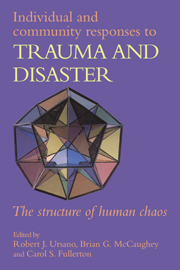Book contents
- Frontmatter
- Contents
- List of contributors
- Foreword
- Preface
- Part I Introduction
- Part II The nature of traumatic stress
- 2 The psychology of terror and its aftermath
- 3 Exposure to traumatic death: the nature of the stressor
- 4 Psychological and psychiatric aspects of technological disasters
- 5 Traumatic effects of accidents
- 6 The human experience of earthquakes
- 7 Psychological effects of toxic contamination
- Part III The role of psychosocial context in responses to trauma and disasters
- Part IV Responses to trauma across the life cycle
- Part V Conclusions
- Index
4 - Psychological and psychiatric aspects of technological disasters
from Part II - The nature of traumatic stress
Published online by Cambridge University Press: 13 October 2009
- Frontmatter
- Contents
- List of contributors
- Foreword
- Preface
- Part I Introduction
- Part II The nature of traumatic stress
- 2 The psychology of terror and its aftermath
- 3 Exposure to traumatic death: the nature of the stressor
- 4 Psychological and psychiatric aspects of technological disasters
- 5 Traumatic effects of accidents
- 6 The human experience of earthquakes
- 7 Psychological effects of toxic contamination
- Part III The role of psychosocial context in responses to trauma and disasters
- Part IV Responses to trauma across the life cycle
- Part V Conclusions
- Index
Summary
The Greek inventor Daedalus was not concerned whether his inventions helped or harmed society. Icarus, his son, joyfully ascended on the wings his father invented. As he flew closer to the sun, however, the wings melted, sending Icarus plummeting into the sea, where he drowned. Man versus nature, man against himself, and man versus technology, is the topic of this paper.
Technology has a dual character. It is able to prevent disasters and to cause disasters. By definition, a technological disaster is the result of a failure of humanmade products. These include air crashes, large scale road accidents, train derailments and collisions, passenger ship and other maritime catastrophes, including oil rig destructions, industrial explosions, oil blowout, large fires of all sorts, mining disasters, nuclear plant accidents, leakages of hazardous substances from toxic waste disposal, etc. In contrast to war, another type of humanmade disaster, technological disaster, is not intended. In a technological disaster, a human action, or a product of human hand (a failed technology), results in the disruption of a community, and, at times, considerable death, injury and destruction.
Technology is certainly becoming safer. Road traffic, airlines, and railways are subject to stringent safety procedures. However, the absolute number of technological disasters is increasing. As technology develops, there are simply more things that can go wrong, even if unintended and uncalculated. When something does go wrong, or a mistake is made, there has been a human error and someone is always responsible.
- Type
- Chapter
- Information
- Individual and Community Responses to Trauma and DisasterThe Structure of Human Chaos, pp. 72 - 102Publisher: Cambridge University PressPrint publication year: 1994
- 20
- Cited by

